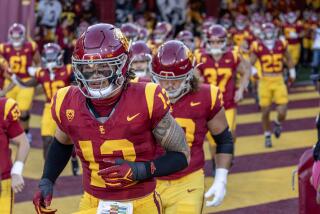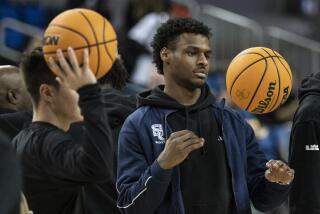Judge Won’t Reinstate Star 49er With 1 Kidney
At 1:15 Monday afternoon, outside a federal courtroom in Los Angeles, Mark Seay had hope as he awaited a hearing. If everything went well, he anticipated playing football again for Cal State Long Beach, as soon as Saturday in a game at Boise State.
“I hope they have room for me,” he said. The remark was made jokingly because the 49ers had lost two days before to Hawaii, 63-10, and it seemed plausible they would welcome back a man who had been a star receiver last season until he lost a kidney in a shooting at a children’s Halloween party.
But less than an hour later, U. S. District Judge Ronald S. W. Lew refused to grant a preliminary junction that would have allowed the 22-year-old junior to rejoin the team. Lew said there was not clear proof that Seay’s remaining kidney is working normally.
Seay sat numbly after the decision, realizing he would not be playing at Boise or anywhere this season. His attorney, Richard J. Foster, a 49er booster and fund-raiser, tried to console him. They did not leave for several minutes.
“He was near tears,” Foster said. “I told him it wasn’t over, that it was the beginning of the fourth quarter and a lot of teams pull it out in the fourth quarter.”
Last month, Seay sued the university because it would not allow him to play, claiming that the risk to his remaining kidney was too great.
Despite Monday’s setback, Foster said he is considering having the case proceed to trial early next year. He said the burden of proof at a trial is less than it is at a preliminary injunction hearing.
The attorney also said that Seay, who will retain his scholarship, may look into the possibility of playing at another school.
Foster had hoped that the testimony of Dr. Stewart W. Shankel, a kidney specialist at Loma Linda University, would be sufficient.
“Mark Seay’s renal (kidney) function is stable,” Shankel said in a declaration filed with the court. “His creatinine clearance has been consistently between 72 and 80 (cubic centimeters per minute). While this clearance is somewhat low, it is within acceptable limits for a person with one kidney.” (Creatinine is a byproduct of muscle metabolism and is excreted through the urine; the clearance is a measure of kidney function.)
Shankel also said in a letter to Dr. Robert Austin, the 49ers’ team physician, that Seay was willing to take the risks of playing football with one kidney and that he should be allowed to play.
But Austin recommended that Seay not be allowed to play. Austin has said that Seay’s kidney is not working properly and would be at substantial risk--from a hard blow to the back or from extreme physical exertion. Austin also said Seay’s creatinine clearance is half what it should be.
“Mark’s kidney function is stable, not normal,” Deputy Atty. Gen. Christopher C. Foley, representing the university, said at the hearing. “We’re not saying he’s an invalid. But is it medically advisable to play? The conservative approach is appropriate.”
CSULB Athletic Director Corey Johnson said Tuesday, “I felt all along the institution had done the proper medical investigations and made the right decision.”
Foster had been encouraged before Monday’s hearing. He said that Seay qualified under the Rehabilitation Act of 1973, which prohibits a university that receives federal money from discriminating against an otherwise qualified handicapped person. He said that, under the act, Seay, rather than the university, should make the decision whether he should play.
Foster also pointed to a report by C.C. Calescibetta, a Long Beach kidney specialist to whom the university sent Seay last March. Calescibetta had recommended that Seay participate in track, not football. “(Track) is a sport generally recognized to be more strenuous than football,” Foster said.
Calescibetta also said that if Seay were allowed to play football, he should wear a flak jacket. Foster said at the hearing Monday that the Douglas Protective Equipment Co. of Houston would make a protective pad for Seay similar to one it made for James Dixon, who has one kidney and played last season as a wide receiver for the University of Houston.
The company claims that a person wearing the pad could be hit with a baseball bat and not feel any pain.
But Foster said that the overriding issue is whether Seay’s remaining kidney is working properly. “He wants conclusive evidence,” Foster said of Lew. “We can’t get him conclusive evidence.”
Foster said that any hope of future success in the case probably will hinge on whether Seay’s kidney function increases, which Austin doubts.
“We will contact some sports medicine people to conduct extensive studies on Mark,” Foster said. “If they come in negative, Mark will have to make a decision whether to pursue (the case).”
Foster accused the university of being “excessively conservative” and that it feared Seay would sue if he played and were injured. The school rejected a waiver offer, the attorney added.
“I think we came darn close (to winning),” Foster said. “I think the judge really struggled with the decision.”
Seay, who became a hero when he shielded his 2-year-old niece from gunfire at the party last Halloween, said after the hearing that he was having a hard time accepting Lew’s decision.
“If I had won this case,” Seay said, “I could live my life the way it used to be.”
More to Read
Go beyond the scoreboard
Get the latest on L.A.'s teams in the daily Sports Report newsletter.
You may occasionally receive promotional content from the Los Angeles Times.










